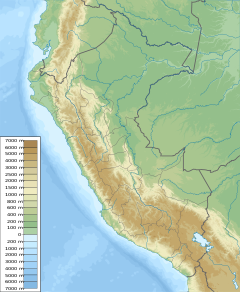Río Abiseo National Park
| Río Abiseo National Park | ||
|---|---|---|
|
|
||
| Location: | San Martín , Peru | |
| Surface: | 2745 km² | |
| Founding: | August 11, 1983 | |
The Río Abiseo National Park was founded on August 11, 1983 by the Peruvian government to protect the cloud forests and the unique flora and fauna. In 1990, UNESCO declared it a world cultural and natural heritage site . The national park is located in the San Martín region and extends over an area of 2745 km². The eponymous river Río Abiseo , a tributary of the Río Huayabamba , and its tributaries Río Monte Cristo and Río Tumac flows through the park .
In the area between 350 m and 4200 m altitude there are seven different habitats that have produced a diverse and species-rich flora and fauna. The cloud forests that lie above the tropical rainforest have the greatest variety of plants. There are ferns , orchids , bromeliads , sugar cane and mosses . A total of 261 genera, 105 families and 980 different plants have been identified so far. Of these, 13 orchid species are unknown to science.
The animal world is similarly rich in species. 11 genera and 13 different mammals are known so far, including the threatened yellow-tailed woolly monkey ( Oreonax flavicauda ), which only occurs here. Other endangered animals are the Andean deer ( Hippocamelus antisensis ), the spectacled bear ( Tremarctos ornatus ) and the golden- forehead spider monkey ( Ateles belzebuth ), for the rare fur armadillo ( Dasypus pilosus ) the national park is one of the few known refuges the king vulture ( Sarcoramphus papa ), the yellow-headed amazon ( Amazona ochrocephala ), the puma diver ( Agouti taczanowskii ) and the roach duck ( Netta erythrophthalma ). Of the IUCN risk than strong ( endangered ) is arranged Gelbbrauenarassari was also observed in the National Park.
The national park is home to 36 pre-Columbian sites that are of inestimable scientific value. The largest and archaeologically most important is Gran Pajatén , which is assigned to the Chachapoya culture and which is called a monumental complex because of its architectural style.
Web links
Single receipts
- ↑ Mariella Superina and Agustín M. Abba: Dasypus pilosus. Edentata 11 (2), 2010, p. 162
- ↑ Lester L. Short and Jennifer FM Horne: Toucans, Barbets and Honeyguides - Ramphastidae, Capitonidae and Indicatoridae . Oxford University Press, Oxford 2001, ISBN 0-19-854666-1 , p. 339

